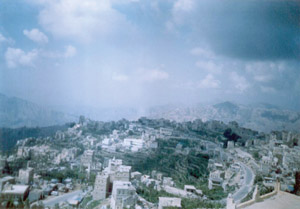
Walking in the clouds on Razih Mountain [Archives:2006/929/Last Page]
March 16 2006
 |
[email protected]
The peace of the idyllic countryside in northwestern Sa'ada governorate was broken by the roar of bulldozers, tractors, scrapers and dump trucks. A wide, paved road – Razih ring road – was in the making. The beauty of Razih Mountain is becoming increasingly within reach.
The way of man
A thousand feet off the ground, the haze lifted as we headed for Razih Mountain. The sandy areas gradually thinned out and there was just a darkish-gray jagged mountain. From this altitude, the mountain took on a faint green tint, almost resembling the mold of a moonscape. From the brightly painted mud and brick houses of the lower valleys, the homes here changed into gray stone construction. A few tiny villages clung precariously to the mountainside here and there.
Small villages and laboriously terraced hills were everywhere. Farming here is a perpetual contest between man and nature. The sun was still shining but black clouds threatened on the horizon as we stepped into cool, crisp air.
In view were the old and the new – sometimes extremes of both, small farm plots, old forts and castles, new houses, new cars, donkeys turning up in narrow alleys at the picturesque fortress like a traditional home. The scene was wild and rugged as we entered another world from the cool air of the mountain. The air was colder still at the top of this beautiful mountain world. Remote villages sat on the flank of the mountain like a large stone fortress.
The edge of Razih Mountain ridge abruptly dropped several thousand feet into wild canyons leading down through the coastal desert to the Red Sea. Green grass, wildflowers and a cool, clear brook all were spiced with the fresh smell of spring. A country lane wound its way up and down gentle slopes, past lush fields of wheat, barley, tomatoes, onions and alfalfa. Peach, apple and plum trees were in the pinkest bloom.
Razih farmers were tilling their fields, plowing and pulling weeds. Every village had a different character – literally a different color – all beautiful and well-cared for. People would come over and invite us in for coffee, and if we wished, a meal.
Meadows and wildflowers shrouded in mist, castles in the air, the smell of time and the art of being – these are changing times.
A mountain dreamland
Isolation and abundant rainfall make Razih so distinctive. Terraced farming, craggy mountain peaks, tall trees and luxuriant coffee plantations – agriculture here requires little or no irrigation. It is assumed that most parts of Razih Mountain receive at least 12 inches of rain annually.
Farming is laid out in broad terraces, some 200 to 300 feet wide, astride the hilly contours of the land. Cereal crops, wheat, barley and millet dominate commercial agricultural production while fruits like apricots, figs, apples and pears are plentiful.
Future development
Razih development began fairly recently. The whole area has changed a lot and will continue to change at an ever-increasing pace. The completion of Razih road and providing electricity are two ongoing projects of major importance for the Razih area. Other efforts include basic improvement of water and roads, and also education and health have high priority. Agricultural advances could be among the most dramatic and innovative.
Change must be slow in order to ensure development for the better. Change that comes fast can be overwhelming, even frightening. Local leaders have little experience in promoting their community's needs to the world, let along managing implementation of these needs. Maybe what is needed is a forum where people and companies can link with individual school and hospital needs to which they can contribute not just funding, but also advice, information and even hard labor. The internet could be such a medium.
The road will improve the area's tourism potential a great deal. Mountain worlds like Razih could be a showcase for self-sustainable tourism aimed at those seeking different experiences, conscious of the importance of social responsibility and environmental integrity and wishing to have experiences that give them new and different perspectives. Such tours could be done with informed tour coordinators to help tourists better understand the culture.
This highland region supports a heavily concentrated population. Providing modern services to isolated communities in developing countries under conditions that ensure projects are both affordable and commercially viable remains an unsolved challenge.
The “bundled service” program, for example, offers another alternative. By enhancing electrical service with telecomm and internet access, projects increase economic opportunities and raise communities' productive capacity.
Utilizing breakthroughs in wireless internet, providing off-grid electricity, telecomm and wireless internet service simultaneously promise that communities will develop productive activities to raise income levels faster than extra services drive up project costs.
——
[archive-e:929-v:14-y:2006-d:2006-03-16-p:lastpage]


